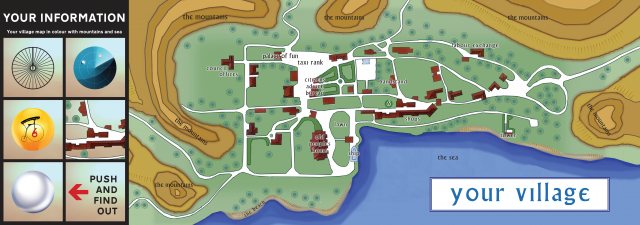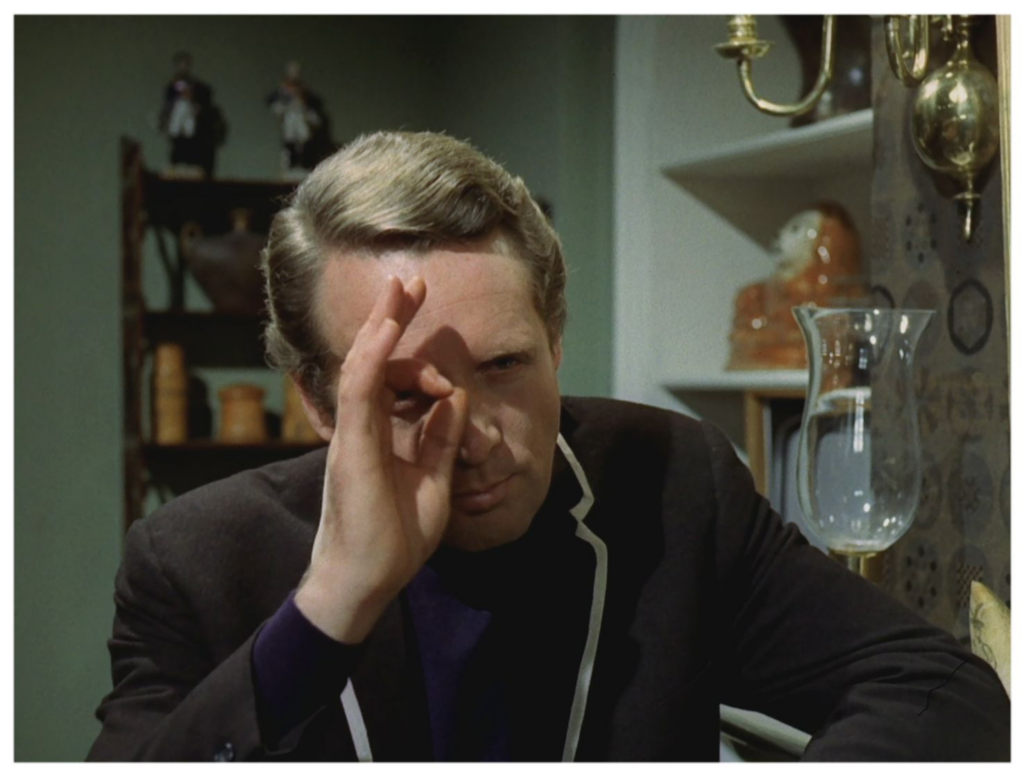The Prisoner Under a Glass – Be Seeing You

When The Prisoner first came out it was so roundly rejected in Great Britain that Patrick McGoohan said, ‘Fine I was born in New York City. I’ll just go back to America. Be seeing you.’ The Village’s officially unofficial salute, an okay symbol over the eye rem iniscent of a spyglass. McGoohan was supposed to have picked that up from a play he was in. It was the last line of an integrator to the prisoner he had been grilling.*
Writing 101; the setting is critical to any story. It is the foundation on which the structure is built. It is the underpainting of a portrait. And it has to be a character in its own right. So, let’s take a look at The Prisoner’s prison; The Village.
Portmeirion Wales was cast as The Village. Patrick McGoohan first visited the resort town while filming an episode of Danger Man. The fact that globalists keep referring to the Global Village gives me the vaguely skin-crawling feeling that The Prisoner was the inspiration for the real-world Number Twos.
Ironic, because Portmeirion started life as an act of rebellion. Sir Bertram Clough Williams-Ellis was its architect, and his life’s work was an outcry against the revolting ugliness of brutalist architecture. Williams-Ellis spent a lot of his life effectively screaming ‘No, I was not copying Portofino. I was trying to show that modern buildings can be beautiful.’ Portmeirion was built with a lot of both the old and the new. Stones from now-demolished buildings were repurposed for its construction, he even rescued the gorgeous plaster ceiling from Emral Hall.

While modern construction techniques and materials were welcome at Portmerion, modern architecture was not.
There was passion behind this resort town. It was built with a purpose and that brings its own energy with it.
While Portmeirion is beautiful, it is also just a bit surreal.
Wales has its own sense of place, its own loci. Portmeirion almost but doesn’t quite fit in. The beauty of it is simply not native to the area. It almost feels like a reflection of somewhere else and perhaps somewhen.
Like an intrusion of the realm of faerie into our world. almost as if the fae are trying to get their façade to look like something by the hand of man but they just can’t quite get it right.
This is exactly what the Irishman McGoohan wanted for his new show.
When the Prisoner first arrives, he wakes up in a room that looks exactly like the room in his London flat where he was gassed into unconsciousness. Shortly after waking up, the first Number Two shows him some photos, clearly shot in his own home, demonstrating to the Prisoner that he had been under close scrutiny for some time. The Prisoner’s London flat living room served as a metaphor, he had already been a prisoner for a while. When he resigned unexpectedly, the powers that be decided to foremalize his incarceration.
I remember discussing The Prisoner with a friend in college, and he said, “And it was his own side that did to him!”
But my friend was wrong, The Village didn’t belong to the British, or the Russians, or Uncle Sam, although all of them were implicated at one point or another. It eventually became clear with time was that the men who controlled the Village also controlled everything else. Which is why there was a genuine attempt by Everyman Films to make The Village as global as possible. Although, frankly that just wasn’t going to happen in 1960s Britain, but it did well enough to make case for the Village being cosomopolitan for the period it was made in.
Adding to this feeling of the vaguely alien was the vacationers themselves. In those days visitors to Portmeirion tended to be Europeans (albeit with plenty of native British middle-aged types on holiday thrown in), and they all had absolutely no idea what was going on during the filming. It helped give the Village an air of a place where most people were given to laughing at the very much wrong things. It’s also why everyone dressed in sixties British holiday wear to include the Prisoner himself.
This sense of the familiar yet alien was vital to the setting. The village was above all else, surreal.
That said, a resort community isn’t ideal for filming everything in, so all the interior shots were done at the MGM studio north of London.
That was where you would find Number Two’s office, Number Six’s plush cell, and of course, Control where the Village’s surveillers worked. There were plenty of observers in Control but they couldn’t watch everyone all at once. The seesaw in the middle of Control was supposed to give the impression that observations were 360 degrees, they could see everywhere but never all at once. However, all of the Villagers knew that they could be under active observation at any given time, they were just never certain when.
The overall effect was that the Village itself was a panopticon-style prison, the prisoners were guarding themselves because they never knew when they were under active observation, so they had to assume they were under surveillance at all the time. Control itself was also under observation by their superiors represented by an eye orb that was constantly circling the room. Reminding the audience that the people who ran the village weren’t so much guards as trustees.
Reinforcing this effect was that the trustees were mostly un-uniformed and living inside the Village with the rest of the prisoners.
The show did what it could to keep the location of the Village as mysterious as possible. For that matter, the basic geography was kept under wraps too. Was the Village on an Island? Was it on a peninsula? You never did get a straight answer to that question. The final episode indicated that it was located somewhere on Albion itself but Fallout was so spacey you can’t really take any of the information from it as useful.
All you ever know about it is that the Village is surrounded by mountains and open to the sea.

So long as we are covering some of the mysteries of the Village in this post, I should mention its unusual livery device: The Penny Farthing big wheel bike you see everywhere in the series. I’ll turn the floor over to Patrick McGoohan for that one:
McGoohan describes the bicycle as an ‘ironic symbol of progress.’ To put it colloquially: The bicycle represents something of the industrial age (beyond the Horse-and-Buggy Era). Beginning with the industrial age, McGoohan muses that we’ve been technologically progressing far faster than we’ve been learning how to cope with our new inventions. Thus, the Penny Farthing bicycle is the icon of the Village.
There, one mystery less and you aren’t putting up with some dumbass explanation like, “It means what it says.”*
The prisoners of the Village were constantly being told, “Remember, this is your Village.” And to party it up as much as possible, always saying what they are supposed to say in public, but at the same time everyone was terrified of saying the wrong thing: “Questions are a burden and answers are a prison to one’s self.”
Translation: Don’t ask questions and avoid answering them when asked by other Villagers. Remember at all times someone is watching or listening to everything you say. This your Village means remember this your prison.
Sound familiar?
Because we are now the Prisoners.
If you want to know the secret of The Prisoner’s continued popularity after fifty years, that’s it. We live in the Village… And remember this is your Village.
Be seeing you.

*This may be apocryphal. I could only find one second-hand source for this.
**Which I have had to dig through a LOT when doing research on these articles.

